Written by: Emma Cyrus, Senior Copy, Content & Editorial Writer
Reviewed by: Cristina Chirila, Senior Interior Designer
Edited by: Zoona Sikander, Head of Content

The integration of technology into residential spaces has transformed how we interact with our homes. Among the most sophisticated advancements are smart curtain blinds – an elegant fusion of traditional window treatments and cutting-edge automation.
For discerning homeowners who value both aesthetic refinement and technological innovation, motorised blinds represent the next evolution in luxury curtains and blinds.
As design consultants to Dubai’s most distinguished residences, we’ve observed a significant shift in client expectations. No longer is it sufficient for window treatments to merely look exceptional – they must perform intelligently, responding to environmental conditions and lifestyle patterns with minimal intervention.
This marriage of form and function perfectly aligns with the contemporary emphasis on homes that offer both visual splendour and technological sophistication.
Understanding Smart Curtain Blind Systems
Smart curtain blinds represent a category of automated window treatments that can be programmed, scheduled, and controlled remotely. Unlike conventional window blinds curtains that rely on manual operation, these systems integrate with home automation platforms, responding to voice commands, smartphone applications, or environmental sensors.
The technology encompasses various styles, from roller blind curtain systems that disappear entirely when not in use to fabric curtain blinds that maintain a softer aesthetic while incorporating motorised functionality. This versatility ensures that automation can be introduced without compromising the design integrity that discerning homeowners demand.
Advantages: Why Discerning Homeowners Are Embracing Automation
Refined Convenience and Elegant Control
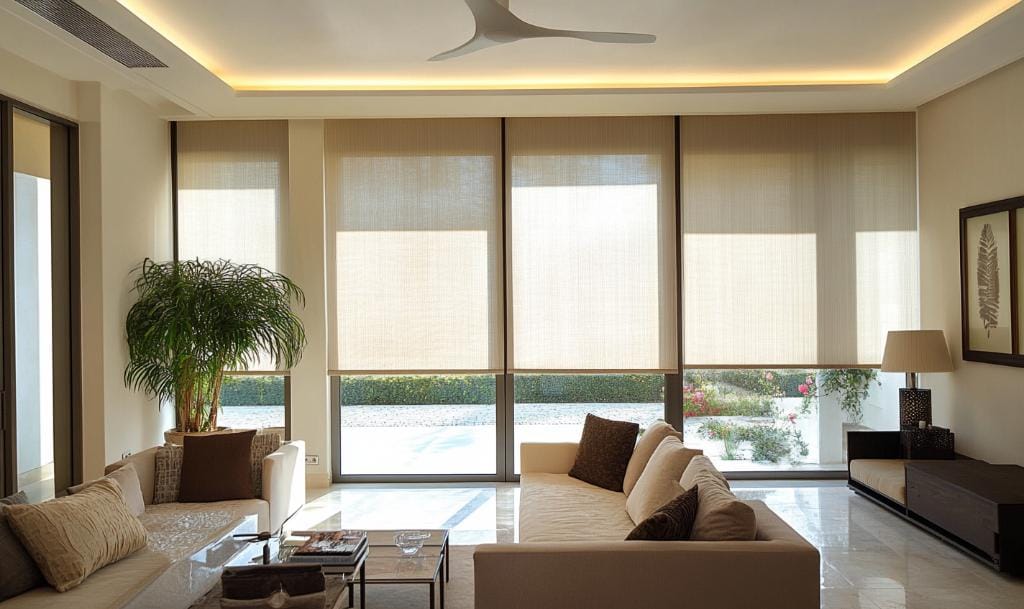
Perhaps the most apparent benefit is the effortless control these systems provide. For properties with extensive glazing or challenging-to-reach windows, the ability to adjust curtains and blinds in Dubai remotely transforms the relationship between architecture and functionality.
During a recent penthouse installation, our client remarked how the system eliminated the daily ritual of manually adjusting multiple window treatments throughout the day – a simple convenience that nonetheless represented a meaningful enhancement to daily living.
Sophisticated Energy Management

Smart window treatments contribute significantly to environmental control and energy efficiency. Programmable systems can respond to changing light conditions, automatically adjusting to maintain optimal temperature and protect valuable interiors from sun damage.
In Dubai’s climate, where managing intense sunlight is a year-round consideration, this functionality proves particularly valuable. One client reported a measurable reduction in cooling costs after installing responsive window blinds and curtains throughout their residence.
Enhanced Security Protocols
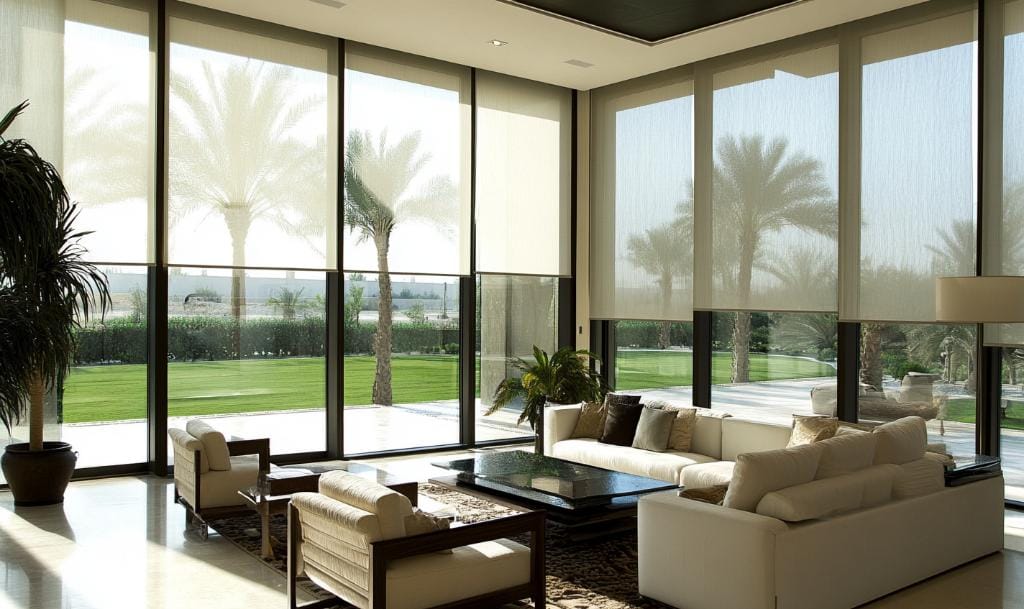
The security implications of automated window treatments are often overlooked yet represent a significant advantage.
When integrated with home security systems, blind curtain mechanisms can be programmed to create the appearance of occupancy during travel periods. This subtle but effective deterrent complements more conventional security measures, adding a layer of protection that operates with sophisticated discretion.
Preservation of Fine Furnishings
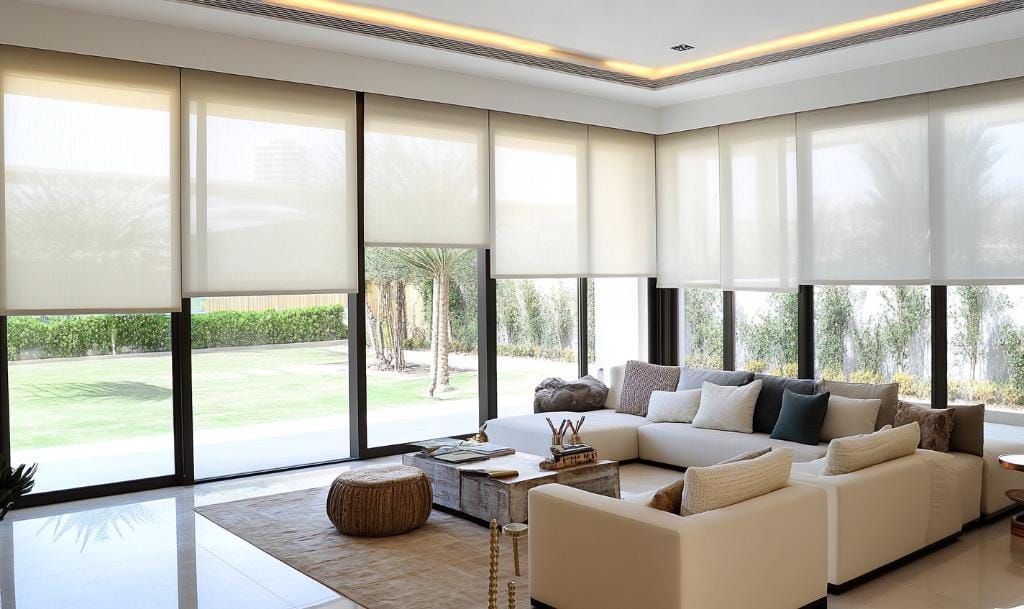
For collectors of art and antiques, the protection of valuable possessions from sun exposure represents a primary concern.
Smart systems can be programmed to adjust based on the sun’s position throughout the day, ensuring that prized pieces receive appropriate protection without requiring constant monitoring. This preservation aspect alone justifies the investment for many collectors, safeguarding pieces that might otherwise require restoration due to light damage.
Potential Limitations: Considerations for the Discerning Client
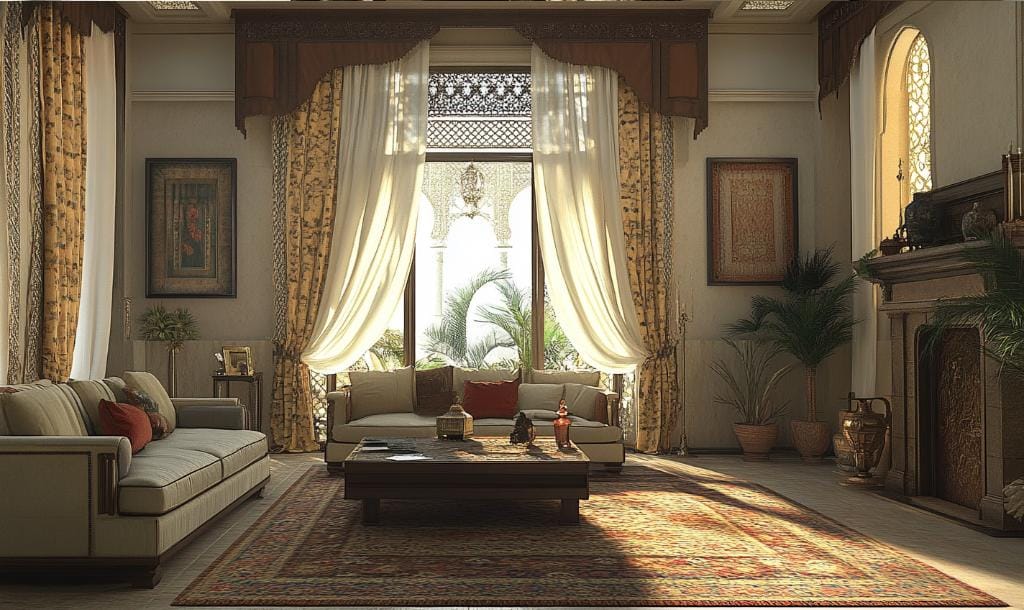
Aesthetic Integration Challenges
While technology has advanced considerably, the mechanisms required for automation can sometimes present design compromises. The most sophisticated systems minimise visual intrusion, but certain architectural contexts may still require careful consideration to ensure that technology doesn’t undermine aesthetic intentions.
In traditional interiors, particularly, finding the proper balance between innovation and design integrity requires experienced guidance.
Technical Complexity and Maintenance Requirements
The best blinds and curtains in traditional form typically require minimal maintenance beyond occasional cleaning.
Smart systems, by contrast, introduce additional complexity that must be considered in the long-term ownership experience. While well-engineered systems prove remarkably reliable, the potential for technical issues cannot be dismissed entirely. Establishing a relationship with specialists who understand both the technological and design aspects of these installations proves essential.
Integration with Existing Systems
For residences with established home automation platforms, ensuring seamless integration between smart curtain blinds and existing systems requires careful planning. While most quality systems offer compatibility with major platforms, the nuances of integration can sometimes present unexpected challenges.
Comprehensive planning during the specification phase prevents complications during implementation.
Investment Considerations
The initial investment in motorised blinds exceeds that of conventional curtains and blinds in Dubai. This premium reflects not only the technology itself but also the expertise required for proper integration.
However, when evaluated against the convenience, energy efficiency, and protection benefits, most clients find the additional investment entirely justified, particularly when amortised over the system’s operational life.
Design Considerations: Balancing Technology and Aesthetics
Fabric Selection for Motorised Blinds
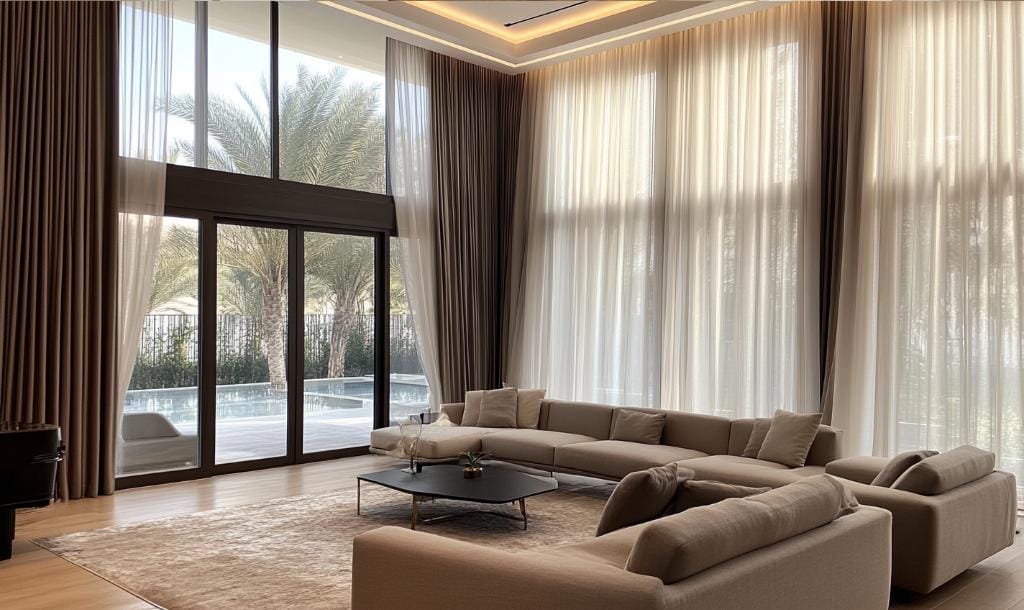
Not all fabrics perform equally well in motorised blinds. The weight, drape, and tensile properties must be carefully considered to ensure proper functionality over time.
Fortunately, manufacturers have developed extensive options specifically engineered for automated systems, ensuring that technical requirements need not compromise design vision. From sheer to blackout, options exist for virtually any aesthetic direction.
Complementary Design Approaches
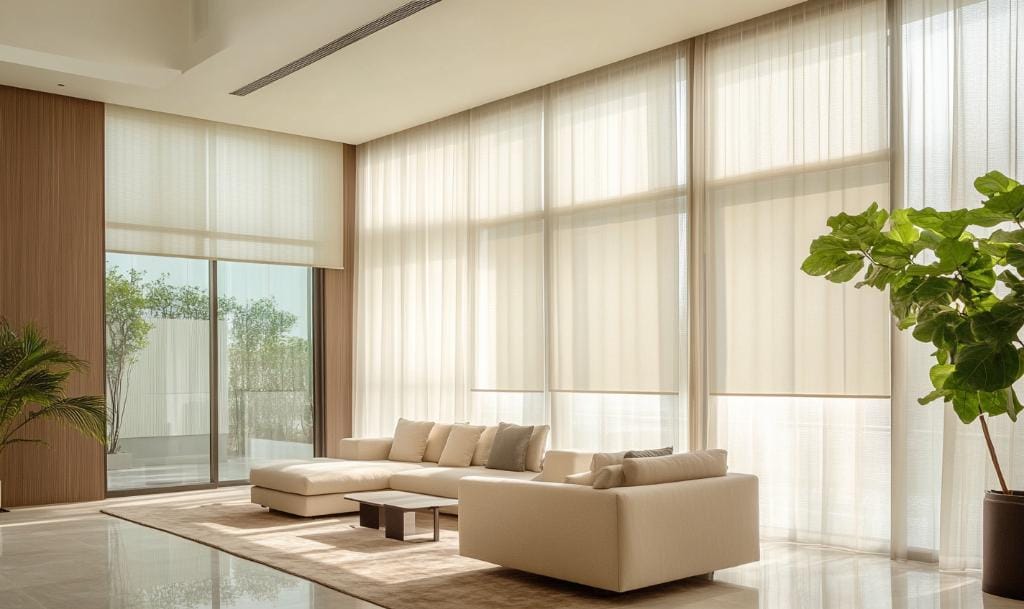
Many sophisticated interiors incorporate layered window treatments – perhaps combining woven blinds with curtains to achieve both functional versatility and aesthetic richness.
This approach allows the automated elements to address practical concerns while more decorative components satisfy aesthetic requirements. In a recent installation, we paired automated roller blinds with sumptuous manual curtains, creating a system that offered both technological convenience and traditional luxury.
Hardware Considerations
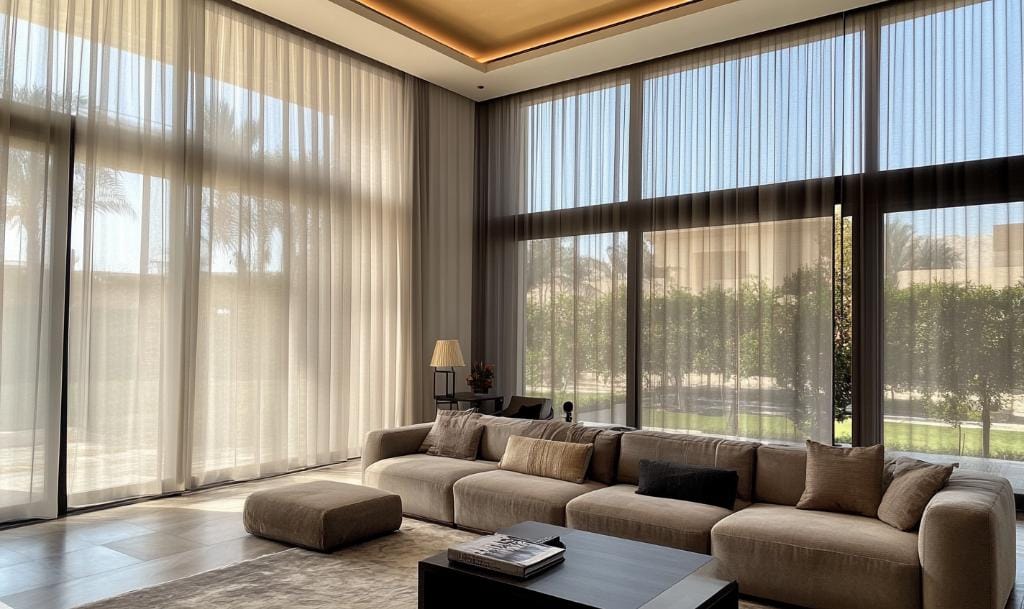
The hardware supporting smart curtain blinds plays a crucial role in both functionality and visual impact. Leading manufacturers have recognised the importance of design coherence, offering mechanisms and control elements that complement rather than detract from interior schemes.
From discreet recessed tracks to elegantly finished exposed components, options exist to satisfy even the most exacting design standards.
Making Informed Decisions: Questions to Consider
Before proceeding with automated window treatments, consider these essential questions:
- What specific functionality would most enhance your daily experience?
- How do you envision controlling your window treatments? Voice, app, schedule, or a combination?
- What are the energy management priorities for your space?
- How will these systems integrate with your existing home automation platform?
- What is your preference regarding visibility of mechanisms and controls?
- Have you considered both the immediate and long-term maintenance implications?
Answering these questions provides a framework for making decisions that balance technological capability with aesthetic intention, ensuring that the final implementation enhances rather than compromises your interior vision.
Key Takeaways
Motorised blinds represent a significant advance in how we interact with our living environments, offering unprecedented control, efficiency, and integration. For those who value both aesthetic refinement and technological sophistication, these systems can transform the experience of a space, elevating conventional luxury to something altogether more responsive and intuitive.
However, successful implementation requires thoughtful consideration of both the opportunities and limitations. Working with specialists who understand not merely the technology but the design implications ensures that your investment enhances your daily experience while maintaining the aesthetic integrity of your home.
When considering window treatments for your residence, we invite you to explore the possibilities that smart systems offer – while remaining mindful that, as with all significant design decisions, the most successful outcomes result from careful planning and expert guidance.



Get in touch
Want to get in touch? We'd love to hear from you. Email us at [email protected]
Sign Up for Newsletter